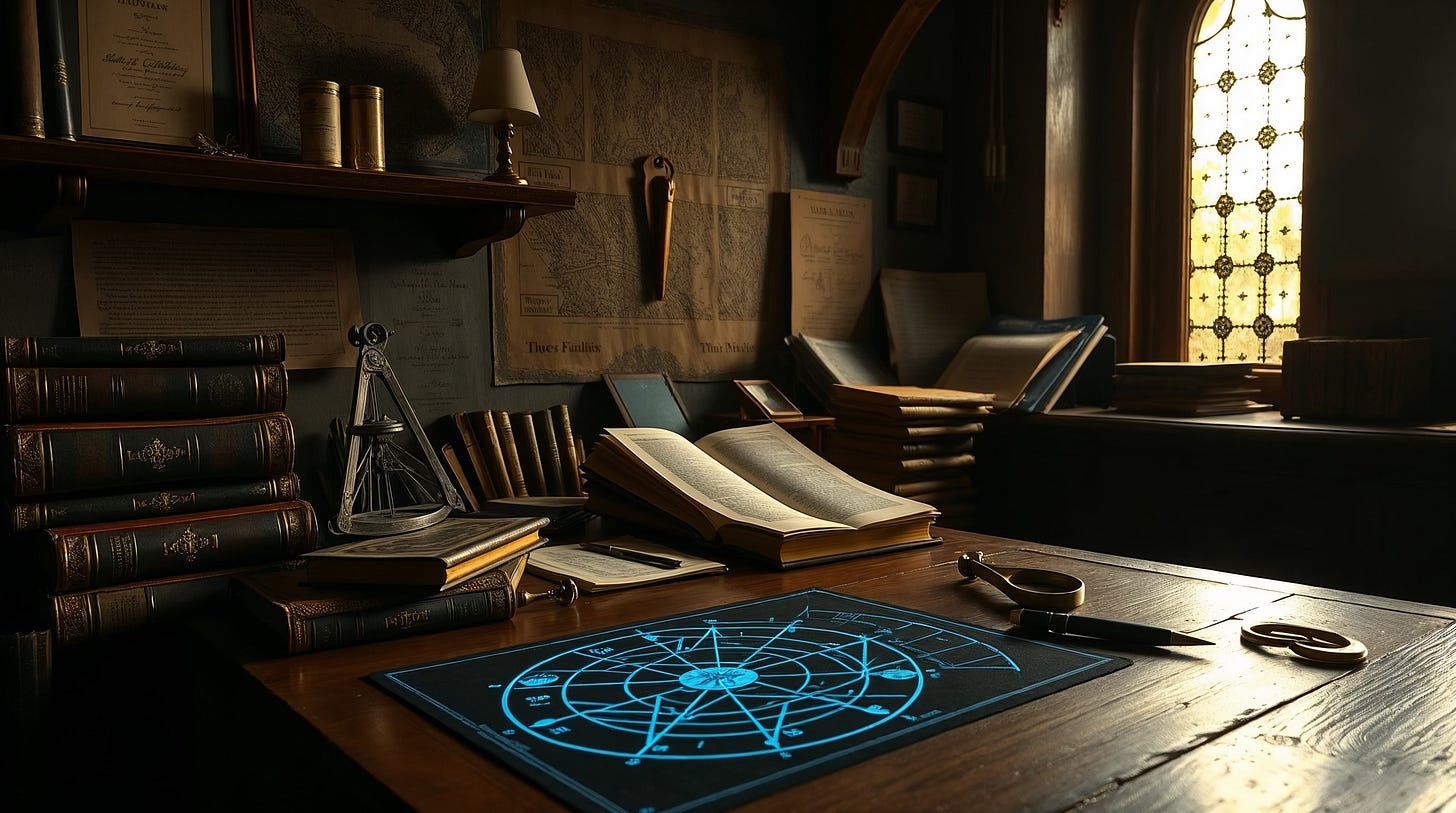The Most Essential Skill in the AI Era is 2,500 Years Old
A modern, yet surprisingly ancient, framework for the timeless art of critical thinking.
In a recent post, I argued that the most productive way to approach AI in our classrooms is to frame AI literacy not as a technical skill, but as a critical and cultural practice. This perspective urges us to shift our focus from the fleeting mechanics of prompt engineering to the timeless, durable habits of mind we’ve always sought to cultivate: ethical reasoning, sound judgment, and above all, critical thinking.
But this argument immediately surfaces a deeper, more urgent question. We educators use the term "critical thinking" constantly. It’s the North Star of our pedagogical mission, the glowing line item in every syllabus. But what do we actually mean by it?
This is not just an academic question. It’s the central challenge of our time. We are caught in the great paradox of AI: a tool that can augment our intellect in profound ways, yet also tempts us into a state of “cognitive offloading,” where our own analytical muscles risk atrophy. Research is already showing some negative correlation between frequent AI use and critical thinking scores, as the frictionless convenience of AI encourages a mental passivity that is the very antithesis of the active, effortful inquiry we want for our students.
To navigate this, we need a definition of critical thinking that is robust enough for the digital age. And to find it, we need to look back. By tracing the 2,500-year evolution of this idea, we can see how humanity has repeatedly forged new intellectual tools in response to new challenges. This journey will show us that the answer isn't to invent a new form of thinking, but to reclaim and expand our most powerful traditions of inquiry for a world of new media.
Our guide for this exploration will be a model I've developed called the Four Lenses of Critical Engagement. This framework helps operationalize our rich definition of critical thinking for the modern world by extending the timeless principles of inquiry to the new forms of media that define our landscape: Critical Reading, Critical Listening, Critical Seeing, and Critical Making. As we trace the history of critical thought, we will see how these four lenses have always been present, and how understanding their evolution gives us a powerful map for the future.
The Ancient Art of Asking Why
Our journey begins, as it so often does, in the bustling agora of Athens with Socrates. His legacy is not a set of answers, but a method of relentless, disciplined questioning that revealed a foundational truth: a confident claim to knowledge is often a mask for an unexamined belief. The Socratic method is the origin of critical thinking as a practice designed to probe the very foundations of thought. Socrates taught us to be suspicious of confident, easy answers, a disposition more vital than ever when generative AI can produce them on any topic, in any style, in an instant. The Socratic spirit—the instinct to ask, “Why do you say that?” or “What are the consequences of that assumption?”—is the original, and still most powerful, antidote to the illusion of authority that AI projects.
This ancient practice is the direct ancestor of two of the core competencies we need today. The Socratic dialogue, a shared exploration of ideas through speech, is the very essence of Critical Listening. It is the skill of not just hearing words, but of analyzing the underlying beliefs and value systems that shape them.
It was Socrates's student, Plato, who recorded these dialogues and, in doing so, drew a sharp distinction between the Socratic pursuit of truth and the rhetoric of the Sophists, who used argumentation merely for persuasion. This ancient tension is startlingly modern. AI’s capacity for "hallucinations", plausible sounding but entirely false statements, is a perfect digital reincarnation of Sophistry: persuasive, but untethered from truth. Plato’s insistence on truth over persuasion is the philosophical bedrock of Critical Reading, which demands that we move beyond a text's surface appeal to evaluate the validity of its claims.
Forging the Tools of Reason
If Socrates gave us the spirit of inquiry, the thinkers who followed sought to build its scaffolding. Aristotle, Plato’s student, created the first systematic toolkit for reasoning, the Organon, giving us the formal language of logic, deduction, and syllogism. He demonstrated that an argument has a structure, and that this structure can be analyzed and evaluated for its validity, separate from its emotional appeal. This was a monumental step, providing a universal grammar for assessing the soundness of an argument, whether we encounter it in an ancient text, a modern news report, or an AI-generated summary.
Centuries later, during the Scientific Revolution, Francis Bacon and René Descartes sparked a second revolution in thought. They argued that the source of authority for knowledge should not be ancient texts or abstract principles, but something new. For Bacon, it was empirical evidence, gathered through systematic observation and experimentation. His greatest contribution, however, may have been identifying the "Idols of the Mind," the innate biases that distort our perception of reality. This call for self-awareness is profoundly relevant today, as algorithms are often designed to exploit our cognitive biases, especially the confirmation bias that keeps us clicking on content we already agree with. Bacon’s demand for empirical proof finds its modern echo in the practice of Critical Seeing: the skill of evaluating visual information, from a scientific chart to a viral video, and demanding that it corresponds to observable reality.
While Bacon looked outward, Descartes looked inward. He introduced "methodic doubt," a systematic skepticism that refused to accept anything as true unless it could withstand rigorous questioning. This is the intellectual discipline we must now apply to the confident, authoritative voice of AI. The Cartesian method is the engine of modern critical inquiry, compelling us to deconstruct an argument, examine its premises, and test its logic before we grant it our belief.
Thinking as a Classroom Practice
For centuries, these were largely the tools of philosophers and scientists. It was the American educator John Dewey who carried them across the threshold of the modern schoolhouse at the turn of the 20th century. He reframed critical thinking, which he called "reflective thinking," as the central purpose of education in a democracy.
Dewey defined it as the "active, persistent, and careful consideration of any belief... in the light of the grounds that support it". The word "active" is the key. It stands in direct opposition to the passive reception of information, a danger that has become exponentially greater in our age of endless scrolling and machine-generated content. Dewey’s philosophy of "Learning by Doing" was a call to engage students in the "desirable difficulty" of constructing their own knowledge through experience, not simply receiving it from an authority, whether that authority is a lecturing teacher or a large language model.
This Deweyan ideal is the direct intellectual foundation for the fourth and final lens of modern critical engagement: Critical Making. This is "Learning by Doing" for the digital age. It recognizes that creating content today requires a conscious, reflective engagement with our tools. It asks us to maintain human agency and ethical awareness, understanding how the tools we use shape our creative choices and how our creations participate in the wider information ecosystem.
A Framework for a New Era of Literacy
This journey reveals that critical thinking is not a single skill but a rich, composite practice. It is a Socratic disposition to question, an Aristotelian toolkit for logic, a scientific commitment to evidence, and a Deweyan mandate for active, experiential learning.
The challenge posed by AI does not require us to invent a new form of thinking. It requires us to expand and adapt these foundational practices for a world where information is no longer confined to the printed page. This brings us back to the core argument of my AI literacy post: true literacy can be taught without ever touching the tool itself, because it is about cultivating a critical mindset. The Four Lenses Framework is a model for doing exactly that. It is not an "AI curriculum"; it is a comprehensive framework for critical thinking in a multi-modal world. AI is the catalyst that makes these skills urgent, but their scope is far broader.
Critical Reading: This is no longer just about analyzing a printed text. It’s about interrogating the logic of hyperlinks, understanding the persuasive architecture of a website, and detecting the subtle biases in algorithmically curated news feeds. It’s a foundational skill for navigating any information system, human or machine-made.
Critical Listening: This skill was essential long before AI-generated voices. It is the ability to analyze the rhetoric of a political speech, to detect the emotional manipulation in an advertisement’s sound design, and to evaluate the credibility of a podcast host. In a world of synthetic audio, this auditory literacy becomes a crucial tool for verification, but its purpose is much larger: to understand how sound shapes belief.
Critical Seeing: We have always needed to be critical of what we see, from Renaissance propaganda paintings to 20th-century photojournalism. Today, this lens applies to deconstructing the narrative of a documentary film, interpreting the potential misrepresentations in a data visualization, and, yes, detecting the subtle impossibilities in an AI-generated image. It is the timeless skill of questioning all visual evidence.
Critical Making: Grounded in Dewey’s philosophy, this lens applies to any act of creation. It encourages students to reflect on how a word processor’s spell-check might homogenize their writing style, how a photo filter changes the emotional meaning of an image, or how collaborating with an AI can both open and close creative pathways. It is the practice of maintaining conscious, ethical control over the creative process, regardless of the tool.
By integrating these four modalities, we can move from a powerful definition of critical thinking to a tangible classroom practice. This approach doesn’t ask us to abandon the core of a humanistic education; it asks us to strengthen it. It reaffirms that our goal is not to train students to be better users of AI, but to empower them to be more discerning thinkers, more ethical citizens, and more self-aware human beings in a world where AI exists.
That is a mission that Socrates, Bacon, and Dewey would surely recognize.





Why take a critical approach at all? For me it is about establishing 'Active Trust'. Trust based on Faith and Belief which are upheld by Proof of Value. Proof can certainly come from hard Evidence. It can also come from private inner Experience. The third form can come from models or proofs of a mathematical provenance, enshrined in recorded Education. Critical imperatives such as Reading, Listening, Seeing and Making, must examine apparent Reality to generate the right mix of Proofs, which will have proportions, or equities, that are unique to each content, context and circumstance. Some will need more Evidence, others more on Experience or Education. If the right mix isn't present, Reality will be doubted and Trust in what is presented will lack Integrity. Critical methods must serve to create aligned Integrity for what can be objectively, experientially and socially validated so the Holy Grail of Critique, Trust, can be established, moderated, sustained and evolved.